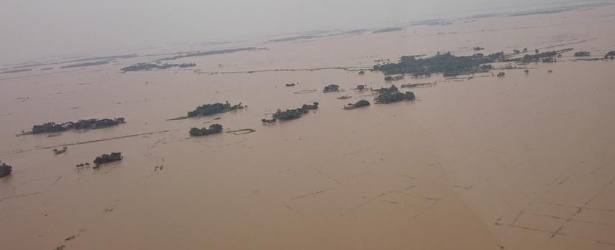India’s monsoon rains are changing – Heavy rain and extreme floods devastate Odisha, India (again)

Heavy rains that started in Indian state of Odisha, Bay of Bengal, mid July continued through August causing deadly floods and destruction. By Sunday, August 10, 2014, death toll climbed to 45, while flood waters affected more than 3 200 000 people. Over 3 million hectares of crops have been flooded in what might be the worst flooding Odisha experienced in more than 30 years.
Flood waters engulfed vast areas of the delta region of Mahanadi river system by August 7, but by today the situation has gradually improved with receding water level in many areas. The discharge of water into sea was also getting slowed down due to yesterday's full moon.
Water level in almost all rivers including Mahanadi dropped considerably, but more than 480 000 people in over 460 villages are still left marooned in its delta. Many areas are still submerged by flood water of Baitarani river, Deputy Relief Commissioner Prabhat Ranjan Mohapatra said.
The situation in several areas of Kendrapara and Puri district remains grim.
#OdishaFloods: Seen here is a snap from #Kendrapada from #Odisha with water rising #rain #india pic.twitter.com/qk5e7OKGZ8
— Bhubaneswar Buzz (@BBSRBuzz) August 6, 2014
Roads & rice fields submerged, villages & hamlets cut off. I flew sorties today for relief distribution #OdishaFloods pic.twitter.com/nOIpDI69jG
— Baijayant Jay Panda (@PandaJay) August 7, 2014
In September 2011 Odisha was hit by worst flooding in 30 years. The flooding, sparked by two spells of heavy monsoon rains, has disrupted the lives of more than 2 million people after submerging over 3 000 villages in the impoverished coastal state. At least 38 people have died. (Trust)
In 2012, late monsoon downpours in India's northeast left some two million people homeless, while just last year over 1 000 people died and tens of thousands were left homeless after early monsoon rains in the northern Indian state of Uttarakhand triggered flash floods and landslides.
The incidence of extreme events, either too much rain, or too little, over a limited period of time, is becoming more widespread in recent years. “Heavy rain events [more than 10 centimeters a day] over central India are increasing while weak and moderate events are decreasing,” India’s minister for science and technology and earth sciences Jitendra Singh told the country’s Parliament on August 06.
This year, scientists at Stanford University released a study examining monsoon patterns over a 60-year period, and concluded that extreme weather events had increased. A news release summarizing the findings explained that “although the average total rainfall during the monsoon season has declined, the variability of rainfall during the peak monsoon months has increased.” In particular, the researchers observed increases in the intensity of wet spells and in the frequency of dry spells. (Quartz)
Featured image: Baijayant Jay Panda via Twitter

Commenting rules and guidelines
We value the thoughts and opinions of our readers and welcome healthy discussions on our website. In order to maintain a respectful and positive community, we ask that all commenters follow these rules:
We reserve the right to remove any comments that violate these rules. By commenting on our website, you agree to abide by these guidelines. Thank you for helping to create a positive and welcoming environment for all.